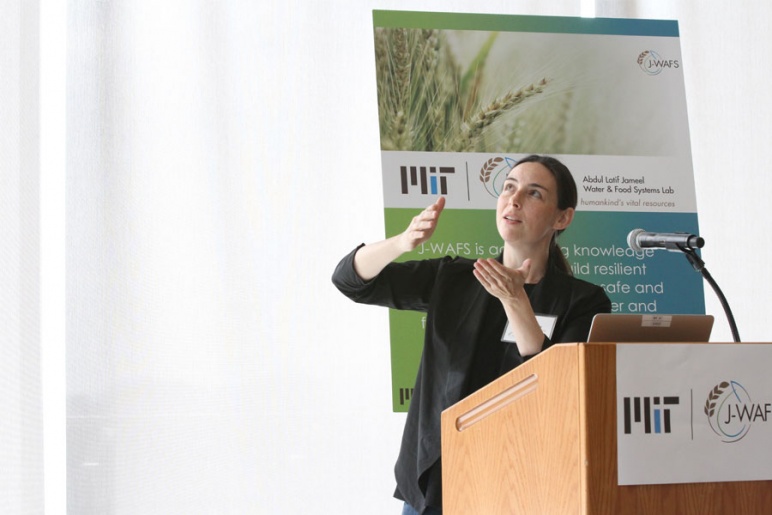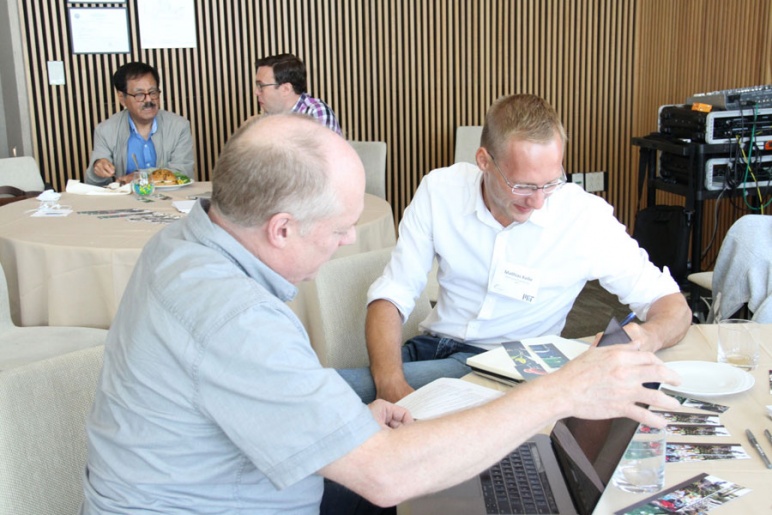News The catalyzing potential of J-WAFS Seed Grants
MIT junior faculty explore new research directions and achieve powerful career advancement enabled by J-WAFS’ mission-driven grant program focused on water and food solutions.
Andi Sutton, Abdul Latif Jameel Water and Food Systems Lab January 13, 2021

Julia Ortony, Finmeccanica Assistant Professor in Materials Science and Engineering and J-WAFS PI presenting at a J-WAFS research workshop. Credit: Andi Sutton

Fadel Adib SM '13, PhD '16, an associate professor of Media Arts and Sciences and Electrical Engineering and Computer Science working with students at the MIT Media Lab. Credit: Ozzy Gunduz, MIT Media Lab

Mathias Kolle (right), Rockwell Career Development Professor in the Department of Mechanical Engineering, discussing research with J-WAFS PI Timothy Swager, a professor in the Department of Chemistry. Credit: Andi Sutton, J-WAFS

David Des Marais (right), Gale Assistant Professor of Civil and Environmental Engineering, working with students on his J-WAFS-funded research in the lab. Credit: Gretchen Ertl

Benedetto Marelli, Paul M. Cook Career Development Professor in the Department of Civil and Environmental Engineering. Credit: Civil and Environmental Engineering, MIT

Joann de Zegher (center), Maurice F. Strong Career Development Professor at the Sloan School of Management, doing field work with smallholder farmers in Indonesia. Credit: Joann de Zegher
“A seed grant for a risky idea that is mission-driven goes a long way.”
These are the words of Fadel Adib SM '13, PhD '16, an associate professor of media arts and sciences and of electrical engineering and computer science at the MIT Media Lab and a 2019 recipient of a two-year seed grant from the Abdul Latif Jameel Water and Food Systems Lab (J-WAFS) at MIT. His work is in wireless sensing, where his research group has largely focused on the development of fundamental technology. It is technology with a mission, however one that—until the J-WAFS seed grant—had largely focused on supporting human health and the environment, but not yet food. “I started with an early project applied to food, but the results were not enough to publish. When I saw the J-WAFS seed grant request for proposals I realized that this was a great way for [my research group] to expand our efforts in the food sector.” The resulting research project, a wireless sensor that uses RFID technology to measure the safety and nutritional quality of food and beverage products, has since inspired him and his research group to delve deeper into food sector research, including exploring potential applications for sustainable aquaculture.
Adib’s story is one of many that J-WAFS PIs—especially junior faculty—have shared about the impact of the seed grant program, illustrating how influential this grant can be. Funding is an essential research driver, with the availability of resources often defining the subject area and scope of individual projects as well as entire careers. Seed grants in particular can be transformational, especially for junior faculty such as Adib, for the opportunity they provide for exploration.
J-WAFS catalyzes research across all disciplines and programs at MIT in order to find solutions to urgent global water and food systems challenges. For MIT faculty coming from technology-dominant disciplines, this emphasis on impact can be invigorating. For Adib, “it allowed [my lab] to do more interdisciplinary work…starting with the problem first rather than the technique.” Mathias Kolle, Rockwell Career Development Professor in the Department of Mechanical Engineering and a J-WAFS grantee, agrees. Kolle received a J-WAFS seed grant in 2017 to develop novel, light-diffusing fibers to increase the energy efficiency of industrial algae production in order to improve its viability as an affordable, environmentally sustainable solution for food and fuel. He commented that the grant proposal and review process itself helped him connect the dots between the technology milestones he sought to pursue and the social impact potential of the project. He credits the prompts sent by the expert reviewers convened by J-WAFS in the final stages of the grant process for “helping me create a pretty convincing picture of why work on algae is important.” Joseph Sandt SM '15, PhD '20, collaborated with Kolle throughout his PhD program in Mechanical Engineering, making the project the focus of his thesis. Kolle comments, “Joseph was very fired up when the J-WAFS project came up.” The research allowed him to build on his existing interest in sustainability while working on an engineering project that still involved a lot of tinkering.
A J-WAFS seed grant inspired yet another junior faculty member to pursue water and food research for the first time: Julia Ortony, Finmeccanica Assistant Professor in Materials Science and Engineering. The 2018 grant she received was her first major grant as a new junior faculty member in DMSE—one that allowed her to work on applied instead of fundamental research for the very first time. “[The J-WAFS seed project] was the first time I really thought about the end product,” she says. Through it, Ortony and her lab develop molecule-based nanofiber hydrogels that are able to bind arsenic and other heavy metals in order to clean drinking water. Ortony recalls, “at the time we received the grant, we were a very new group. It was hard for us to get a big federal grant without preliminary data.” The J-WAFS grant served as an important catalyst. Data from the J-WAFS project drove another successful grant, the Professor Amar G. Bose Research Grant, which enabled the continuation of the J-WAFS research in a different state of matter. “We wouldn’t have been able to explore solid state nanomaterials without the knowledge we gained from the J-WAFS project,” Ortony comments. Since then, she has received additional follow-on funding in the form of a CAREER award from the National Science Foundation, which will enable her research team to develop their understanding of the fundamentals of the nanofiber materials in order to learn how to tune it to even more effectively pull heavy metal contaminants from water. “The J-WAFS seed grant has allowed our group to make a right turn and think about the goal of our research from an applications perspective,” comments Ortony. “We are now doing this in other domains too, outside of water purification.”
The mission-oriented focus of the J-WAFS seed grant attracted another junior faculty member: Joann de Zegher, Maurice F. Strong Career Development Professor at the Sloan School. Joann joined MIT in the fall of 2018 after completing a PhD and postdoctoral fellowship at Stanford University. While there, she had been working on the sustainability of global supply chains, focusing on contract design that more effectively aligns incentives with global sourcing and sustainability. Unlike Kolle, Adib, and Ortony, de Zegher had already begun working in the food sector, having pivoted toward understanding supply chain management to support the sustainability of informal food systems. Her 2019 J-WAFS seed grant is supporting the development of mobile supply chain platforms to support sustainable palm oil production by smallholder farmers in Indonesia. Fieldwork is essential to de Zegher’s research, yet “fieldwork is expensive,” she says, and noted that “When it comes to the study of informal supply chains, like smallholder farmers in Indonesia, it's hard to find opportunities to fund things like travel and student research assistants.” This is where her 2019 J-WAFS seed grant has proved influential. It “provides an important complement to the funding from foundations that supports field operations.” The J-WAFS funding for travel, fieldwork, and a full-time student supporting data collection and analysis has enabled “that extra-mile data analysis that could have been missing” had de Zegher not received the grant.
The solutions-oriented approach that the seed grant program takes welcomes cross-disciplinary, collaborative approaches to problem solving. J-WAFS has funded many interdepartmental research collaborations in which junior faculty have been involved. One such collaboration is between David Des Marais, and Gale Assistant Professor of Civil and Environmental Engineering, and Caroline Uhler, Henry L. & Grace Doherty Associate Professor of Electrical Engineering and Computer Science. They are working on a J-WAFS-backed project to find the genetic foundations of plant tolerance to the stresses of heat and drought. Comments Des Marais, “collaboration with Caroline is transformational. The methods that she developed through the J-WAFS project are changing the way I think about how to tackle my research questions.”
Another junior faculty member from Civil and Environmental Engineering, Benedetto Marelli, has found a research collaboration enabled by a J-WAFS seed grant impactful. Marelli is collaborating with A. John Hart, a professor in the Department of Mechanical Engineering. The two are developing an edible, silk-based food safety sensor that changes color when exposed to bacteria. “Teaming up with a senior faculty member is a good way for junior faculty members to let others know what you are doing,” said Marelli. What is more, for him the experience has involved a lot of mentoring. “Working with John [on the project], I was able to see how a really developed lab operates. As a junior faculty member, you need to immediately learn about finances, mentoring, teaching, and advising. It’s overwhelming.” Working so closely with Hart on their seed grant project, Marelli has learned from his example and shortened his own learning curve.
These few examples of how J-WAFS seed grants have influenced junior faculty at MIT provide a snapshot of the range of water and food systems research topics being pursued across the Institute. The catalyzing potential of J-WAFS seed grants not only supports these faculty members’ career advancement, but also helps to push the boundaries of water and food systems research overall. In Joann de Zegher’s words, seed grant funded research is “early-stage research—you don’t know how it’s going to play out.” In order to go after some of the most challenging problems in water and food systems, “you need that freedom and flexibility.”
